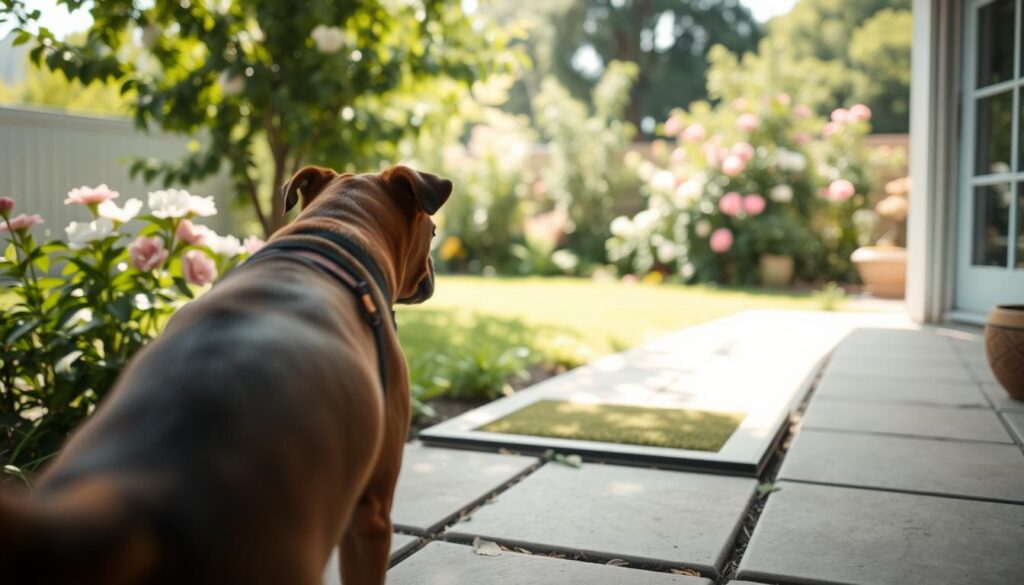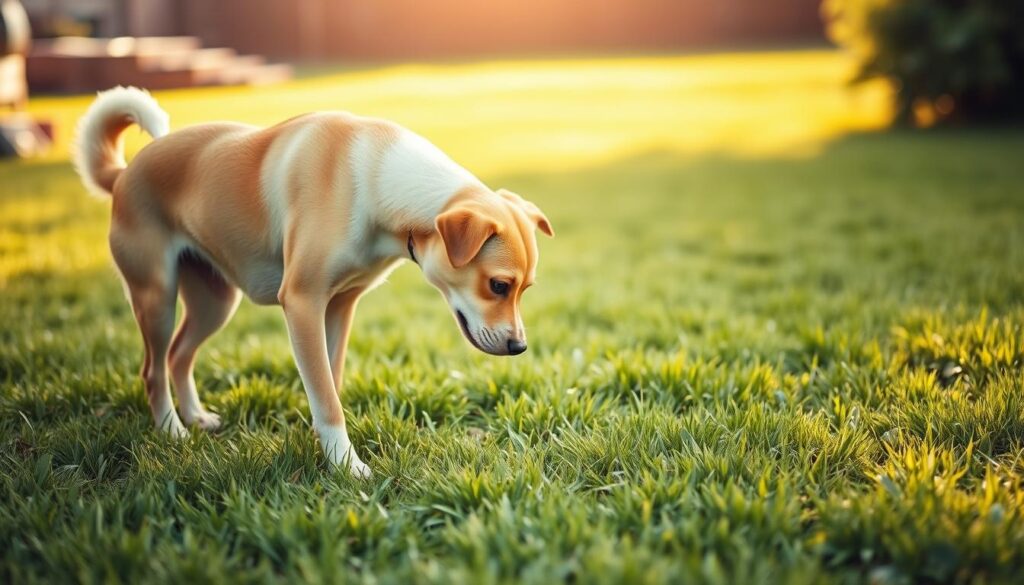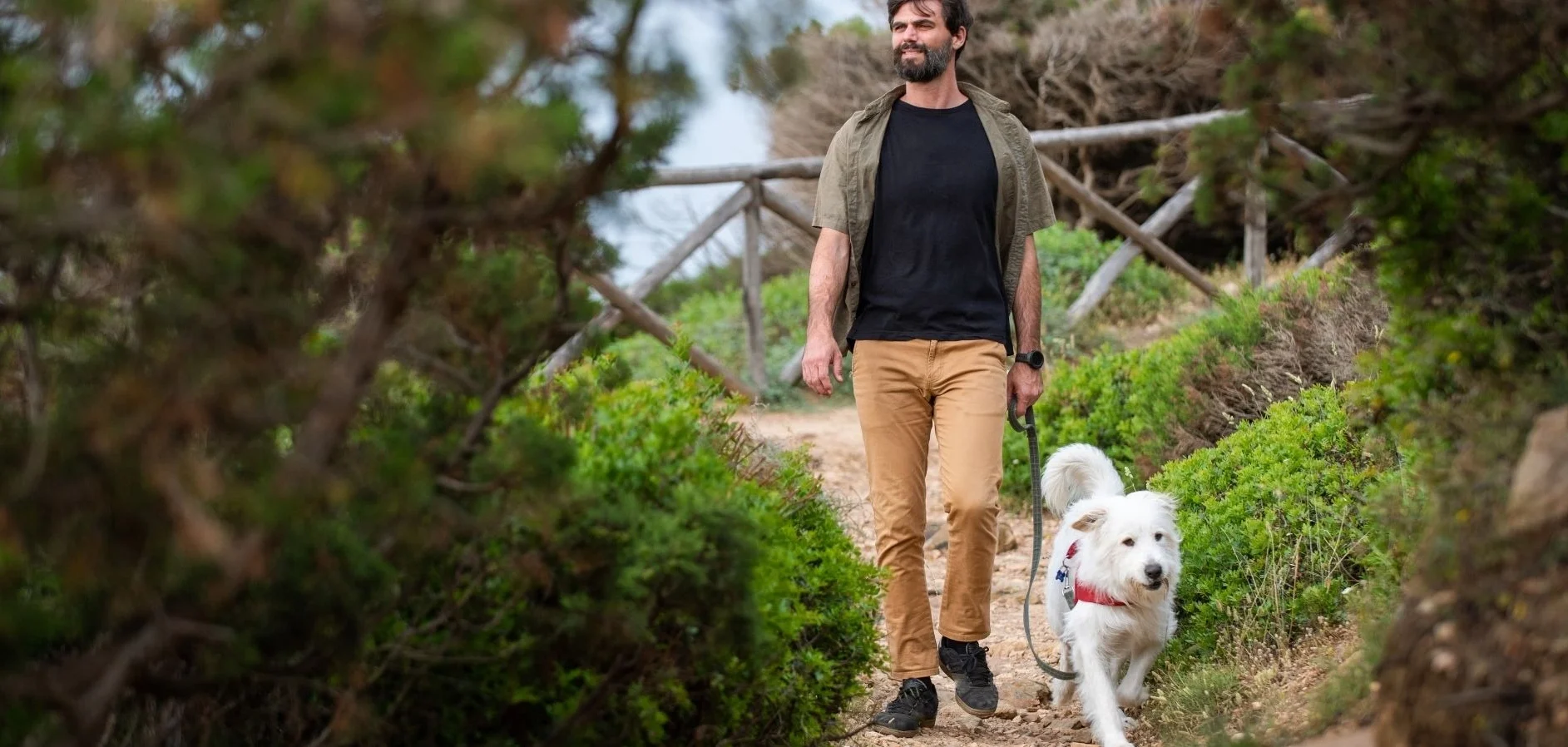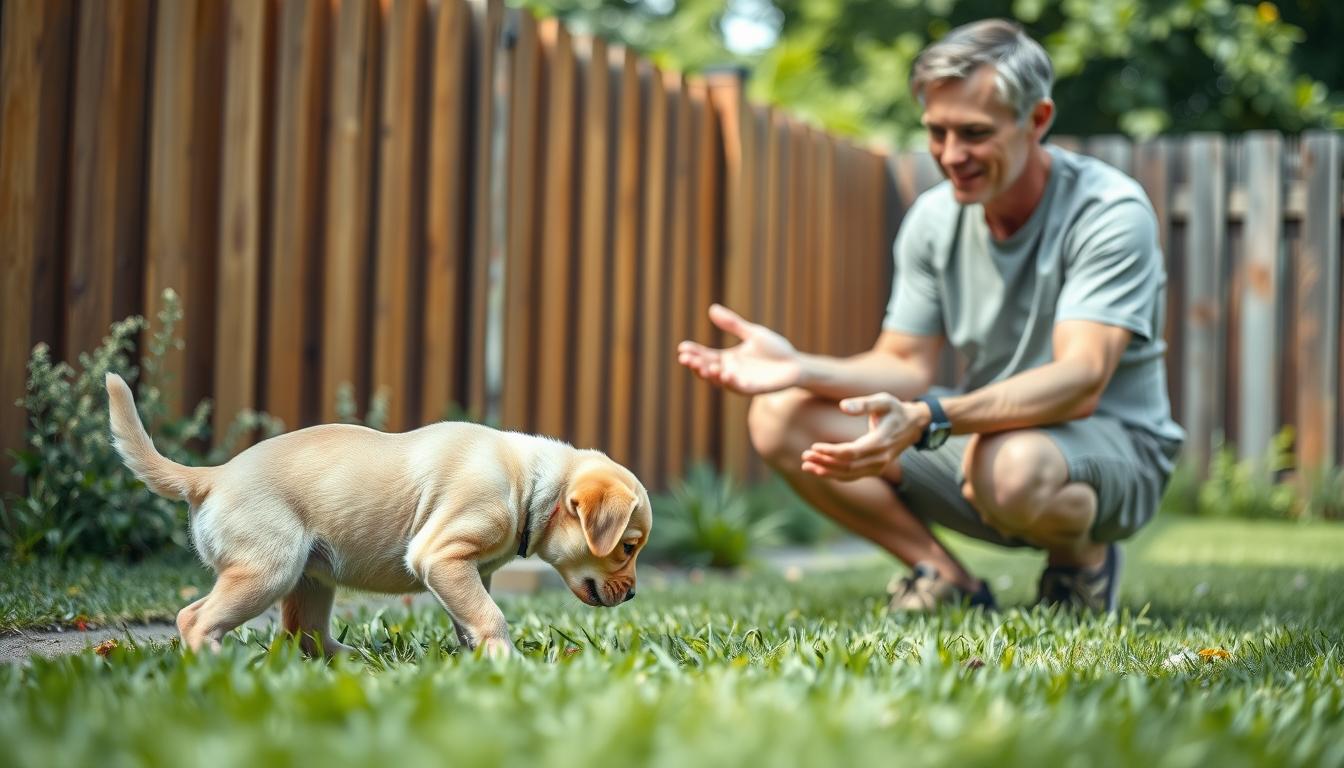How to Train a Dog to Pee Outside: 5 Easy Steps for Success
Table of Contents
How to Train a Dog to Pee Outside
Every dog owner faces the challenge of potty training. I remember the frustration of cleaning endless puddles. But the joy of teaching my rescue pup to pee outside was worth it.
Training your dog to pee outside is more than keeping your floors clean. It’s about building a deeper connection with your furry friend. This journey transforms messy moments into bonding opportunities.
With patience, consistency, and a positive approach, any dog can learn to pee outside. Whether you have a new puppy or an older dog, the key is understanding, communication, and gentle reinforcement.
Key Takeaways
- Patience is crucial in successful dog potty training
- Consistent routine helps dogs learn faster
- Positive reinforcement works better than punishment
- Every dog learns at their own pace
- Establish a clear outdoor bathroom area
- Regular breaks are essential for young dogs
- Celebrate small successes during training
Understanding Your Dog’s Natural Instincts
Housebreaking a dog starts with knowing their natural behaviors and how they communicate. Dogs are complex, with instincts that guide their bathroom habits and how they interact with their world.
Canine bathroom habits are linked to their survival instincts. As descendants of den animals, dogs naturally want to keep their living areas clean. This instinct is key when training your dog.
The Importance of Natural Instincts in Training
Knowing your dog’s instincts can greatly help in housebreaking. Dogs naturally avoid soiling their living space. This makes crate training and setting up specific bathroom areas more effective.
- Dogs seek secure, enclosed spaces for elimination
- They have an innate desire to keep their den clean
- Territorial marking is a natural communication method
How Dogs Communicate Their Needs
Dogs send out signals when they need to go outside. It’s important to recognize these signs for successful bathroom habits.
| Signal | Meaning |
|---|---|
| Whining | Urgent need to eliminate |
| Circling | Preparing to urinate or defecate |
| Scratching at door | Request to go outside |
“Understanding your dog’s natural communication is the key to successful bathroom training.” – Professional Dog Trainer
Patience and consistent observation are essential in learning your dog’s unique communication style during housebreaking.
Choosing the Right Spot for Bathroom Breaks
Starting toilet training for dogs means picking the best spot for them to pee outside. They need a place that’s safe, familiar, and comfortable. The right spot can make a big difference in their bathroom habits.
When picking the perfect spot for your dog’s outdoor toilet, look for these things:
- Quiet and low-traffic location
- Protected from extreme weather conditions
- Easy accessibility for both you and your dog
- Relatively flat and stable ground
- Away from high-activity zones
Creating a Consistent Bathroom Zone
Consistency is key in toilet training dogs. Dogs love routine and knowing what to expect. By picking a specific spot for them to pee, you help them learn where to go.
- Choose a specific spot in your yard
- Always lead your dog to the same location
- Use verbal cues like “go potty”
- Reward immediately after successful bathroom breaks
Tips for Maintaining the Bathroom Area
Keep the outdoor bathroom area clean and inviting. Remove waste quickly and use natural markers or scent attractants. Patience and positive reinforcement are essential for successful training.
Establishing a Routine for Bathroom Breaks
Dog potty training works best with a consistent schedule. Young puppies need to go out often because they can’t hold it long. This helps teach them to pee outside.
Having a set routine stops accidents and teaches good habits. It’s important to know your dog’s needs and find a schedule that fits both of you.
The Benefits of Frequent Scheduled Breaks
Regular breaks are great for dog potty training:
- They help build bladder control and muscle strength.
- They reduce accidents inside the house.
- They make bathroom habits predictable.
- They improve communication between you and your dog.
Signs Your Dog Needs to Go Outside
It’s key to know when your dog needs to go. Look for these signs:
- Restlessness or pacing
- Sniffing around specific areas
- Circling in one spot
- Whining or scratching at the door
- Sudden change in behavior
Puppies need to go out every 1-2 hours. Adult dogs can wait longer. Adjust your schedule based on your dog’s age, size, and needs.
Positive Reinforcement Techniques for Training
Training your dog to pee outside needs patience and the right way. Positive reinforcement training is the best method. It rewards good behavior instead of punishing mistakes.
When teaching your dog to pee outside, rewards are key. Dogs love positive encouragement that makes them feel good and motivated.
The Power of Treats and Praise
Effective positive reinforcement gives rewards right after your dog goes outside. It’s important to link the good behavior with positive results.
- Use high-value treats your dog loves
- Offer verbal praise in an excited tone
- Pet and show genuine enthusiasm
- Reward within 3 seconds of the action
Consistency is Key: Reinforcing Good Behavior
Successful training needs everyone’s effort. All family members should use the same positive approach. This avoids confusion and speeds up learning.
| Reward Type | Effectiveness | Recommended Frequency |
|---|---|---|
| Treats | High | Every successful outdoor bathroom break |
| Verbal Praise | Medium-High | Immediately after action |
| Physical Affection | Medium | After treat and praise |
Remember, patience is your best tool in positive reinforcement training. Every dog learns at their own speed. Stay consistent and supportive.
Common Training Mistakes to Avoid
Toilet training for dogs can be tough, especially when owners make mistakes. Knowing and avoiding these errors can greatly help your dog learn to use the toilet.
Overreacting to Indoor Accidents
One big mistake is getting too upset when your dog has an accident inside. Yelling or punishing your dog can make them scared and anxious. This makes it harder to housebreak them.
Dogs do better with positive rewards than harsh corrections.
- Avoid yelling or physical punishment
- Clean accidents thoroughly to remove odor triggers
- Stay calm and redirect your dog’s behavior
The Impact of Inconsistent Schedules
Being inconsistent can really mess up your training. Dogs like knowing what to expect and when.
| Inconsistent Behavior | Potential Consequences |
|---|---|
| Irregular feeding times | Unpredictable bathroom needs |
| Sporadic potty breaks | Increased indoor accidents |
| Changing training methods | Confusion for the dog |
Housebreaking needs patience, consistency, and a clear plan. By avoiding these mistakes, you’ll make training easier and less stressful for both you and your dog.
Dealing with Reluctance to Go Outside
Teaching a dog to pee outside can be tough when they don’t want to go. It’s important to understand why they might feel this way. This helps in teaching them good bathroom habits.

Some dogs get anxious about going outside because of their environment. Knowing what makes them uncomfortable helps make going outside better for them.
Identifying Hidden Fears
Dogs might not want to go outside because of certain things:
- Loud noises from traffic or construction
- Unfamiliar ground textures
- Previous negative outdoor experiences
- Weather conditions like rain or cold
Gradual Exposure Techniques
Using a gentle method helps your dog get used to going outside:
- Start with short, positive outdoor sessions
- Choose quiet, calm areas for initial training
- Use treats and enthusiastic praise
- Create a consistent routine
| Fear Trigger | Recommended Strategy |
|---|---|
| Noise Sensitivity | Gradually introduce outdoor sounds |
| Texture Discomfort | Provide familiar ground coverings |
| Weather Concerns | Use protective gear, choose optimal times |
Patience is key when teaching a dog to pee outside. Every small success builds confidence and helps establish positive canine bathroom habits.
Using Crate Training to Aid in Bathroom Training
Crate training for puppies is a great way to teach them to go potty outside. Dogs naturally want to keep their sleeping area clean. This makes crates a good tool for teaching them to go to the bathroom in the right place.
When crate training is done right, it helps your puppy learn to control their bladder. It also teaches them good bathroom habits. The important thing is to make the crate a positive, safe space, not a place of punishment.
How Crates Support Potty Training
- Limits your puppy’s ability to have accidents around the house
- Creates a controlled environment for learning
- Helps establish a consistent bathroom routine
The right size crate is key for successful potty training. Your puppy should have enough room to stand, turn around, and lie down comfortably.
Essential Tips for Successful Crate Training
- Choose a crate that fits your puppy’s current size
- Make the crate comfortable with soft bedding
- Introduce the crate gradually with positive reinforcement
- Never use the crate as punishment
“A crate is your puppy’s den – a safe, personal space that should always feel welcoming.”
Remember, patience is key during crate training. Young dogs need time to adjust and learn. With consistent positive reinforcement, your puppy will see the crate as a comfortable and secure space.
Transitioning from Indoor to Outdoor Peeing
Changing your dog from indoor potty pads to outdoor peeing needs patience and a smart plan. It’s a natural process that works with consistent training and positive feedback.

To teach your dog to pee outside, start with a gradual plan. This helps them get used to new habits without feeling stressed or confused.
Creating a Smooth Transition Plan
Your plan should include small steps that make outdoor peeing rewarding for your dog. Here are some important steps:
- Begin by placing indoor potty pads near the exit door
- Slowly make indoor potty areas smaller
- Start taking your dog outside at regular times
- Give treats and praise when they pee outside
Helping Your Dog Adapt to New Environments
Dogs might find new outdoor surfaces and conditions tricky at first. Here are ways to help them get used to it:
| Technique | Purpose |
|---|---|
| Consistent Location | Make a special spot for outdoor bathroom breaks |
| Positive Reinforcement | Use treats and praise for successful outdoor peeing |
| Patience | Give your dog time to feel comfortable outside |
Remember, every dog learns at their own pace. Stay flexible and supportive during training.
Troubleshooting: What to Do When Things Don’t Work
Housebreaking a dog can be tough. If your dog’s toilet training isn’t going well, don’t lose hope. Every dog learns differently, and it’s okay to hit bumps along the way.
If your dog keeps having accidents inside, it’s time to check your training. Look for patterns in when and where accidents happen. Are they at certain times or in specific spots? These clues can help you find what’s not working in your training.
Assessing Training Progress
First, look at your consistency and routine. Dogs do best with regular schedules for bathroom breaks. Make sure you’re taking your dog out often and rewarding them when they go outside. Even small changes in timing or rewards can help a lot.
Seeking Professional Help if Needed
If patience and following training tips don’t work, it’s time to get help. A vet can check for health issues that might be causing problems. A professional dog trainer can give you strategies that fit your dog’s unique needs and how they learn.
FAQ
How long does it typically take to potty train a dog?
The time it takes to potty train a dog varies. It depends on the dog’s age, breed, and how quickly they learn. Puppies usually take 4-6 months, but some dogs might need up to a year. Being consistent, patient, and using positive reinforcement is key.
What should I do if my dog has an accident inside?
Don’t punish your dog for accidents. Clean the area with an enzymatic cleaner to remove smells. If you catch them in the act, take them outside right away. Reward them when they go in the right spot.
How often should I take my puppy outside to pee?
Puppies need to go out often. Take them every 1-2 hours, after waking up, eating, and playing. Remember, puppies can hold their bladder for about an hour for each month of age, plus one.
Is crate training effective for potty training?
Crate training can be very effective. Dogs don’t like to soil their sleeping area. Make sure the crate is the right size and use it positively, not as punishment.
What if my dog is afraid to go outside?
Start by making going outside positive. Use treats and toys to encourage them. Begin with short trips outside and gradually increase the time. Address any fears they may have and be patient and consistent.
How do I transition from indoor pee pads to outdoor peeing?
Move the pee pad closer to the door and then outside, making it smaller each time. Always take your dog to the same spot outside and reward them. Be patient and keep a regular routine.
What are signs that my dog needs to go outside?
Look for signs like whining, circling, or sniffing the floor. Each dog is different, so learn their unique signals. Pay attention to their behavior to know when they need to go.
When should I seek professional help for potty training?
Get professional help if accidents keep happening, if your dog shows medical signs, or if training doesn’t work. A vet can check for health issues, and a dog trainer can offer personalized advice.
There are no reviews yet. Be the first one to write one.


